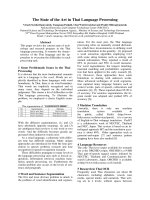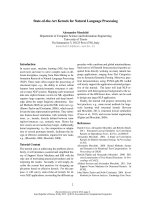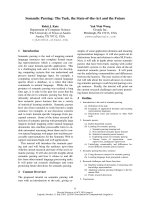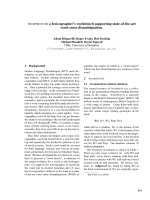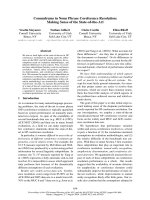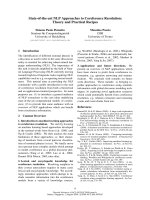multiple criteria optimization state of the art annotated bibliographic surveys (international series in operations research & management science)
Bạn đang xem bản rút gọn của tài liệu. Xem và tải ngay bản đầy đủ của tài liệu tại đây (25.96 MB, 1,085 trang )
MULTIPLE CRITERIA
DECISION ANALYSIS:
STATE OF THE ART SURVEYS
Recent titles in the
INTERNATIONAL SERIES IN
OPERATIONS RESEARCH & MANAGEMENT SCIENCE
Frederick S. Hillier, Series Editor, Stanford University
Zhu, J. / QUANTITATIVE MODELS FOR PERFORMANCE EVALUATION AND BENCHMARKING
Ehrgott, M. & Gandibleux, X.
/
MULTIPLE CRITERIA OPTIMIZATION: State of the Art Annotated
Bibliographical Surveys
Bienstock, D. / Potential Function Methods for Approx. Solving Linear Programming Problems
Matsatsinis, N.F. & Siskos, Y.
/ INTELLIGENT SUPPORT SYSTEMS FOR MARKETING
DECISIONS
Alpern, S. & Gal, S. / THE THEORY OF SEARCH GAMES AND RENDEZVOUS
Hall, R.W./
HANDBOOK OF TRANSPORTATION SCIENCE - Ed.
Glover, F. & Kochenberger, G.A. / HANDBOOK OF METAHEURISTICS
Graves, S.B. & Ringuest, J.L. / MODELS AND METHODS FOR PROJECT SELECTION:
Concepts from Management Science, Finance and Information Technology
Hassin, R. & Haviv, M./ TO QUEUE OR NOT TO QUEUE: Equilibrium Behavior in Queueing
Systems
Gershwin, S.B. et al/ANALYSIS & MODELING OF MANUFACTURING SYSTEMS
Maros, I./ COMPUTATIONAL TECHNIQUES OF THE SIMPLEX METHOD
Harrison, T., Lee, H. & Neale, J./ THE PRACTICE OF SUPPLY CHAIN MANAGEMENT: Where
Theory And Application Converge
Shanthikumar, J.G., Yao, D. & Zijm, W.H./ STOCHASTIC MODELING AND OPTIMIZATION
OF MANUFACTURING SYSTEMS AND SUPPLY CHAINS
Nabrzyski, J., Schopf, J.M., GRID RESOURCE MANAGEMENT: State of the Art
and Future Trends
Thissen, W.A.H. & Herder, P.M./ CRITICAL INFRASTRUCTURES: State of the Art in Research
and Application
Carlsson, C., Fedrizzi, M., & Fullér, R./ FUZZY LOGIC IN MANAGEMENT
Soyer, R., Mazzuchi, T.A., & Singpurwalla, N.D./ MATHEMATICAL RELIABILITY: An
Expository Perspective
Chakravarty, A.K. & Eliashberg, J./ MANAGING BUSINESS INTERFACES: Marketing,
Engineering, and Manufacturing Perspectives
Talluri, K. & van Ryzin, G./ THE THEORY AND PRACTICE OF REVENUE MANAGEMENT
Kavadias, S. & Loch, C.H./ PROJECT SELECTION UNDER UNCERTAINTY: Dynamically
Allocating Resources to Maximize Value
Brandeau, M.L., Sainfort, F., Pierskalla, W.P./
OPERATIONS RESEARCH AND HEALTH CARE:
A Handbook of Methods and Applications
Cooper, W.W., Seiford, L.M., Zhu, J./ HANDBOOK OF DATA ENVELOPMENT ANALYSIS:
Models and Methods
Luenberger, D.G./
LINEAR AND NONLINEAR PROGRAMMING,
Ed.
Sherbrooke, C.C./ OPTIMAL INVENTORY MODELING OF SYSTEMS: Multi-Echelon Techniques,
Second Edition
Chu, S C., Leung, L.C., Hui, Y. V., Cheung, W./ 4th PARTY CYBER LOGISTICS FOR AIR
CARGO
Simchi-Levi, Wu, Shen/ HANDBOOK OF QUANTITATIVE SUPPLY CHAIN ANALYSIS: Modeling
in the E-Business Era
Gass, S.I. & Assad, A.A./ AN ANNOTATED TIMELINE OF OPERATIONS RESEARCH: An
Informal History
Greenberg, H.J./ TUTORIALS ON EMERGING METHODOLOGIES AND APPLICATIONS IN
OPERATIONS RESEARCH
Weber, C./ UNCERTAINTY IN THE ELECTRIC POWER INDUSTRY: Methods and Models for
Decision Support
* A list of the early publications in the series is at the end of the book *
MULTIPLE CRITERIA
DECISION ANALYSIS:
STATE OF THE ART SURVEYS
Edited by
JOSÉ FIGUEIRA
University of Coimbra
SALVATORE GRECO
University of Catania
MATTHIAS EHRGOTT
University of Auckland
Springer
eBook ISBN: 0-387-23081-5
Print ISBN: 0-387-23067-X
Print ©2005 Springer Science + Business Media, Inc.
All rights reserved
No part of this eBook may be reproduced or transmitted in any form or by any means, electronic,
mechanical, recording, or otherwise, without written consent from the Publisher
Created in the United States of America
Boston
©2005 Springer Science + Business Media, Inc.
Visit Springer's eBookstore at:
and the Springer Global Website Online at:
Contents
List of Figures
List of Tables
Introduction
José Figueira, Salvatore Greco, Matthias Ehrgott
Human Reflection about Decision
Technical Reflection about Decision: MCDA Researchers
before MCDA
The Reasons for this Collection of State-of-the-Art Surveys
A Guided Tour of the Book
Acknowledgment to the Referees
References
Part I
An Overview of MCDA Techniques Today
Paradigms and Challenges
Bernard Roy
What Are the Expectations that Multicriteria Decision Aiding
(MCDA) Responds to?
Three Basic Concepts
How to Take Into Account Imperfect Knowledge?
An Operational Point of View
Conclusion
References
Part II
Foundations of MCDA
Preference Modelling
Meltem Öztürk, Alexis Tsoukiàs, Philippe Vincke
Introduction
Purpose
Nature of Information
Notation and Basic Definitions
Languages
1.
2.
3.
4.
5.
1
1.
2.
3.
4.
5.
2
1.
2.
3.
4.
5.
xiii
xvii
xxi
xxi
xxii
xxiv
xxv
xxxiv
xxxiv
3
4
7
12
14
17
18
27
28
28
30
32
33
vi
MULTIPLE CRITERIA DECISION ANALYSIS
Preference Structures
Domains and Numerical Representations
Logic of Preferences
Conclusion
References
Conjoint measurement tools for MCDM
Denis Bouyssou, Marc Pirlot
Introduction and Motivation
Definitions and Notation
The Additive Value Model in the “Rich” Case
The Additive Value Model in the “Finite” Case
Extensions
References
Part III Outranking Methods
ELECTRE Methods
JoséFigueira, Vincent Mousseau, Bernard Roy
Introduction: A Brief History
Main Features of ELECTRE Methods
A Short Description of ELECTRE Methods
Recent Developments and Future Issues
Software and Applications
Conclusion
References
PROMETHEE Methods
Jean-Pierre Brans, Bertrand Mareschal
History
Multicriteria Problems
The PROMETHEE Preference Modelling Information
The PROMETHEE I and II Rankings
The GAIA Visual Interactive Module
The PROMETHEE VI Sensitivity Tool (The “Human Brain”)
PROMETHEE V: MCDA under Constraints
The PROMETHEE GDSS Procedure
The DECISION LAB Software
References
Other Outranking Approaches
Jean-Marc Martel, Benedetto Matarazzo
Introduction
Other Outranking Methods
6.
7.
8.
9.
3
1.
2.
3.
4.
5.
4
1.
2.
3.
4.
5.
6.
5
1.
2.
3.
4.
5.
6.
7.
8.
9.
6
1.
2.
39
48
56
59
60
73
74
89
92
102
112
119
133
134
136
139
149
151
153
153
163
164
164
168
171
175
181
182
183
186
189
197
198
198
Contents
Pairwise Criterion Comparison Approach
One Outranking Method for Stochastic Data
Conclusions
References
Part IV
Multiattribute Utility and Value Theories
MAUT – Multiattribute Utility Theory
James S. Dyer
Introduction
Preference Representations Under Certainty and Under Risk
Ordinal Multiattribute Preference Functions for the Case of
Certainty
Cardinal Multiattribute Preference Functions for the Case of Risk
Measurable Multiattribute Preference Functions for the Case of
Certainty
The Relationships Among the Multiattribute Preference Functions
Concluding Remarks
References
UTA Methods
Yannis Siskos, Evangelos Grigoroudis, Nikolaos F. Matsatsinis
Introduction
The UTA Method
Variants of the UTA Method
Applications and UTA-based DSS
Concluding Remarks and Future Research
References
The Analytic Hierarchy and Analytic Network Processes for the
Measurement of Intangible Criteria and for Decision-Making
Thomas L. Saaty
Introduction
Pairwise Comparisons; Inconsistency and the Principal Eigenvector
Stimulus Response and the Fundamental Scale
Hospice Decision
Rating Alternatives One at a Time in the AHP – Absolute
Measurement
Paired Comparisons Imply Dependence
When is a Positive Reciprocal Matrix Consistent?
In the Analytic Hierarchy Process Additive Composition is Necessary
Benefits, Opportunities, Costs and Risks
On the Admission of China to the World Trade Organization (WTO)
The Analytic Network Process (ANP)
3.
4.
5.
7
1.
2.
3.
4.
5.
6.
7.
8
1.
2.
3.
4.
5.
9
1.
2.
3.
4.
5.
6.
7.
8.
9.
10.
11.
vii
221
254
259
260
265
266
267
273
278
281
290
292
294
297
298
302
313
328
334
335
345
346
348
354
359
369
372
373
375
377
378
382
viii
MULTIPLE CRITERIA DECISION ANALYSIS
Two Examples of Estimating Market Share – The ANP with a Single
Benefits Control Criterion
Outline of the Steps of the ANP
Complex Decisions with Dependence and Feedback
Conclusions
References
On the Mathematical Foundation of MACBETH
Carlos A. Bana e Costa, Jean-Marie De Corte, Jean-Claude Vansnick
Introduction
Previous Research and Software Evolution
Types of Preferential Information
Numerical Representation of the Preferential Information
Consistency – Inconsistency
Consistency Test for Preferential Information
Dealing with Inconsistency
The MACBETH Scale
Discussion About a Scale
MACBETH and MCDA
References
Part V Non-Classical MCDA Approaches
Dealing with Uncertainties in MCDA
Theodor J Stewart
What is Uncertainty?
Probabilistic Models and Expected Utility
Pairwise Comparisons
Risk Measures as Surrogate Criteria
Scenario Planning and MCDA
Implications for Practice
References
Choice, Ranking and Sorting in Fuzzy Multiple Criteria Decision Aid
Patrick Meyer, Marc Roubens
Introduction
The Data Set
Valued Preference Relation and Outranking Relation
Aggregation Procedures
The Sorting Problem
The TOMASO Method
The Choice Problem
Conclusion
References
12.
13.
14.
15.
10
1.
2.
3.
4.
5.
6.
7.
8.
9.
10.
11
1.
2.
3.
4.
5.
6.
12
1.
2.
3.
4.
5.
6.
7.
8.
389
400
403
405
406
409
410
412
414
415
416
417
420
432
435
437
438
445
446
450
454
457
460
466
467
471
472
474
475
478
482
483
502
503
504
Contents
ix
Decision Rule Approach
Salvatore Greco, Benedetto Matarazzo,
Introduction
Dominance-based Rough Set Approach (DRSA) to Multiple-criteria
Classification
Variable-Consistency Dominance-Based Rough Set Approach (VC-
DRSA)
Induction of Decision Rules from Rough Approximations of Upward
and Downward Unions of Decision Classes
Extensions of DRSA
DRSA for Multiple-criteria Choice and Ranking
Conclusions
References
Fuzzy Measures and Integrals in MCDA
Michel Grabisch, Christophe Labreuche
Introduction
Measurement Theoretic Foundations
Unipolar Scales
Bipolar Scales
Ordinal Scales
Concluding Remarks
References
Verbal Decision Analysis
Helen Moshkovich, Alexander Mechitov, David Olson
Features of Unstructured Decision Problems
Main Principles of Verbal Decision Analysis
Decision Methods for Multicriteria Alternatives Ranking
Decision Methods for Multicriteria Alternatives’ Classification
Place of Verbal Decision Analysis in MCDA
Conclusion
References
Part VI Multiobjective Mathematical Programming
Interactive Methods
Pekka Korhonen
Introduction
Basic Definitions and Some Theory
Principles for Implementing Interactive Methods
Generating Nondominated Solutions
Solving Multiple Objective Problems
Final Solution
Examples of Software Systems: VIG and VIMDA
13
1.
2.
3.
4.
5.
6.
7.
14
1.
2.
3.
4.
5.
6.
15
1.
2.
3.
4.
5.
6.
16
1.
2.
3.
4.
5.
6.
7.
507
508
511
525
527
536
544
555
557
563
564
566
570
583
595
604
604
609
610
610
615
625
628
633
634
641
642
643
645
649
652
656
657
x
MULTIPLE CRITERIA DECISION ANALYSIS
Concluding Remarks
References
Multiobjective Programming
Matthias Ehrgott, Margaret M. Wiecek
Introduction
Problem Formulation and Solution Concepts
Properties of the Solution Sets
Conditions for Efficiency
Generation of the Solution Sets
Approximation of the Pareto Set
Specially Structured Problems
Current and Future Research Directions
Conclusions
References
Multiple Objective Linear Programming with Fuzzy Coefficients
Masahiro Inuiguchi
Introduction
Problem Statement and Approaches
Modality Constrained Programming Approach
Modality Goal Programming
Modal Efficiency Approach
Concluding Remarks
References
MCDM Location Problems
Stefan Nickel, Justo Puerto, Antonio M. Rodríguez-Chía
Introduction
Location Problems
Continuous Multicriteria Location Problems
Multicriteria Network Location Problems
Multicriteria Discrete Location Problems
Conclusions
References
Part VII
Applications
Multicriteria Decision Aid/Analysis in Finance
Jaap Spronk, Ralph E. Steuer, Constantin Zopounidis
Introduction
Financial Decision Making
MCDA in Portfolio Decision-Making Theory
MCDA in Discrete Financial Decision-Making Problems
8.
17
1.
2.
3.
4.
5.
6.
7.
8.
9.
18
1.
2.
3.
4.
5.
6.
19
1.
2.
3.
4.
5.
6.
20
1.
2.
3.
4.
661
662
667
668
669
673
675
676
692
696
707
708
708
723
724
725
731
749
754
757
757
761
762
764
767
776
783
787
787
799
800
801
819
835
Contents
xi
Conclusions and Future Perspectives
References
MCDA and Energy Planning
Danae Diakoulaki, Carlos Henggeler Antunes, António Gomes Martins
Introduction
Multiobjective Programming Models for Energy Planning
Energy Planning Decisions with Discrete Alternatives
Conclusions
References
Multicriteria Analysis in Telecommunication Network Planning and
Design – Problems and Issues
João Clímaco, José Craveirinha
Motivation
Overview of Current Evolutions in Telecommunication Networks and
Services
Multicriteria Analysis in Telecommunication Network Planning and
Design
Review and Discussion of Applications of MA to Telecommunication
Network Planning
Future Trends
References
Multiple Criteria Decision Analysis and Sustainable Development
Giuseppe Munda
The Concept of Sustainable Development
Measuring Sustainability: The Issue of Sustainability Assessment
Indexes
A Defensible Axiomatic Setting for Sustainability Composite Indi-
cators
Warning! Not Always Rankings Have to Be Trusted
The Issue of the “Quality of the Social Decision Processes”
The Issue of Consistency in Multi-Criteria Evaluation of
Sustainability Policies
Conclusion
References
Part VIII MCDM Software
Multiple Criteria Decision Support Software
H. Roland Weistroffer, Charles H. Smith, Subhash C. Narula
Introduction
Software Overview
Concluding Remarks
5.
21
1.
2.
3.
4.
22
1.
2.
3.
4.
5.
23
1.
2.
3.
4.
5.
6.
7.
24
1.
2.
3.
848
849
859
860
863
874
890
891
899
900
900
908
912
941
944
953
954
958
963
966
971
976
980
981
989
990
990
1009
xii
MULTIPLE CRITERIA DECISION ANALYSIS
References
Contributing Authors
Index
1011
1019
1035
List of Figures
Graphical representation of R.
Matrix representation of R.
Graphical representation of the semiorder.
Comparing the length of two rods.
Comparing the length of composite rods.
Using standard sequences.
Building a standard sequence on
Building a standard sequence on
The grid.
The entire grid.
The Thomsen condition.
Restricted solvability on
Value function when is discrete.
Value function when is continuous.
Inferring parameter values for ELECTRE TRI.
Preference function.
Valued outranking graph.
The PROMETHEE outranking flows.
Profile of an alternative.
Projection on the GAIA plane.
Alternatives and criteria in the GAIA plane.
PROMETHEE II ranking. PROMETHEE decision axis
and stick.
Piloting the PROMETHEE decision stick.
“Human Brain”.
Two types of decision problems.
Conflict between DM’s.
Overview PROMETHEE GDSS procedure.
Main window.
2.1
2.2
2.3
3.1
3.2
3.3
3.4
3.5
3.6
3.7
3.8
3.9
3.10
3.11
4.1
5.1
5.2
5.3
5.4
5.5
5.6
5.7
5.8
5.9
5.10
5.11
5.12
5.13
34
34
55
78
79
81
94
95
96
97
99
100
106
107
151
169
172
173
175
176
177
179
180
181
182
186
186
187
xiv
MULTIPLE CRITERIA DECISION ANALYSIS
PROMETHEE rankings, action profiles, GAIA plane.
Walking weights.
Set of feasible weights.
ORESTE flow chart.
Outranking graph.
Geometrical interpretation of preferences indices.
Indifference areas.
Indifference areas: rectangular.
Indifference areas: rhomboidal.
Indifference areas: elliptical.
Aggregated semiorder structure.
Aggregated pseudo-order structure.
Partial profile of action
Partial profiles and partial broken lines of
Partial frequencies of
Determination of a relation between the two alternatives
on the basis of the values of global indices.
Partial preorder.
Choice between two lotteries.
Additive Independence Criterion for Risk.
Piecewise linear approximation of
Piecewise linear approximation of
The aggregation and disaggregation paradigms in MCDA [44].
The disaggregation-aggregation approach [96].
The normalized marginal value function.
Post-optimality analysis [43].
Ordinal regression curve (ranking versus global value).
Normalized marginal value functions.
A non-monotonic partial utility function [18].
Distributional evaluation and marginal value function.
Distribution of the actions and on [43].
Simplified decision support process based on disaggre-
gation approach [44].
Methodological flowchart of MARKEX [63].
Comparisons according to volume.
To choose the best hospice plan, one constructs a hierar-
chy modeling the benefits to the patient, to the institution,
and to society. This is the benefits hierarchy of two sep-
arate hierarchies.
5.14
5.15
6.1
6.2
6.3
6.4
6.5
6.6
6.7
6.8
6.9
6.10
6.11
6.12
6.13
6.14
6.15
7.1
7.2
7.3
7.4
8.1
8.2
8.3
8.4
8.5
8.6
8.7
8.8
8.9
8.10
8.11
9.1
9.2
188
188
202
210
215
228
232
233
234
234
236
236
241
242
243
254
259
279
280
289
289
300
301
303
306
307
313
316
319
321
329
332
359
361
List of Figures
xv
To choose the best hospice plan, one constructs a hierar-
chy modeling the community, institutional, and societal
costs. This is the costs hierarchy of two separate hierarchies.
Employee evaluation hierarchy.
Hierarchies for rating benefits, costs, opportunities, and risks.
Prioritizing the strategic criteria to be used in rating the BOCR.
How a hierarchy compares to a network.
The supermatrix of a network and detail of a component
in it.
The supermatrix of a hierarchy with the resulting limit
matrix corresponding to hierarchical composition.
School choice hierarchy composition.
Supermatrix of school choice hierarchy gives same re-
sults as hierarchic composition.
The clusters and nodes of a model to estimate the relative
market share of Walmart, Kmart and Target.
The clusters and nodes of a model to estimate the relative
market share of footware.
Hierarchy for rating benefits, opportunities, costs and risks.
Example of sub-type b inconsistency.
Example of incompatibility between (
*
) and (
**
).
Procedure for all cases of inconsistency.
Suggestion of change to resolve inconsistency.
Matrix of judgements and basic MACBETH scale.
Representations of the MACBETH scale.
“Greatest” closed intervals included in the free and de-
pendent intervals.
Comparing two fuzzy intervals.
Interpretation of the discriminant functions.
Representation of the students problem.
Classes for
Classes for
Visual representation of the classes,
Results for the neighbour algorithm,
Decision tree representing knowledge included from Table 13.1.
The hierarchy of attributes and criteria for a car classifi-
cation problem.
Different cases of interaction.
Ternary alternatives for
9.3
9.4
9.5
9.6
9.7
9.8
9.9
9.10a
9.10b
9.11
9.12
9.13
10.1
10.2
10.3
10.4
10.5
10.6
10.7
12.1
12.2
12.3
12.4
12.5
12.6
12.7
13.1
13.2
14.1
14.2
362
371
380
381
384
385
385
388
388
391
398
405
417
424
431
433
434
435
437
476
493
495
496
497
499
501
535
544
578
593
xvi
MULTIPLE CRITERIA DECISION ANALYSIS
Illustrating the projection of a feasible and an infeasible
aspiration level point onto the nondominated surface.
An example of the Pareto Race screen.
The screen of the computer-graphics interface in VIMDA.
Fuzzy inequality and equality relations.
L-R fuzzy number
Possibility and necessity measures.
Differences among six extended fuzzy relations.
Relations among VWF, WF1, WF2, MF1, MF2, SF1,
SF2 and
VSF.
Relations among VWF, MF1, MF2 and VSF.
Fuzzy max
Symmetric triangular fuzzy number defined by
and
Two differences between fuzzy numbers and
The neo-classical view on the objective of the firm.
Situations leading to MCDA in the firm.
A bird’s-eye view of the framework.
Feasible regions Z of (MC-Unrestr) and (MC-Bounds)
for the same eight securities.
Continuous, bullet-shaped, and unbounded feasible re-
gion Z created by securities A, B and C.
Nondominated frontiers as a function of changes in the
value of upper bound parameter
An ellipsoidal feasible region projected onto two dimen-
sional risk-return space
Typical hierarchical structure of criteria used in energy
planning.
MCDA methods in energy planning applications.
State transition diagram.
Example of priority regions.
A systemic vision of sustainability issues.
Impact matrix for the 4 chosen cities according to the
selected indicators.
The ideal problem structuring in SMCE.
16.1
16.2
16.3
18.1
18.2
18.3
18.4
18.5
18.6
18.7
18.8
18.9
18.10
20.1
20.2
20.3
20.4
20.5
20.6
20.7
21.1
21.2
22.1
22.2
23.1
23.2
23.3
651
660
661
726
728
731
736
739
740
746
746
748
751
811
812
817
826
827
830
834
882
888
914
930
956
967
975
List of Tables
Principal t-norms and t-conorms.
Various with
Evaluation of the 5 offices on the 5 attributes.
Evaluation table.
Weights of relative importance.
Types of generalised criteria Preference function).
Single criterion net flows.
Rank evaluation of alternatives (impact matrix).
The concordance/discordance indices.
Concordance matrix.
Rank evaluation of alternatives (impact matrix).
Regime matrix.
Position-matrix.
City-block.
Preference matrix for a criterion with ordinal evaluation.
Preference matrix for a criterion (Max) with evaluation
on a ratio scale.
Preference importance table for
Combined preferences with weights variable.
Evaluation of alternatives*.
Criteria and (ordinal scales).
Criterion (ordinal scale).
Criterion (ratio scale MIN).
Preference structure of weights.
Pairwise comparison between and
Axiomatic system of MAPPAC basic indices.
Preference indices.
Table of observed stochastic dominances.
Explicable concordances indices.
2.1
2.2
3.1
5.1
5.2
5.3
5.4
6.1
6.2
6.3
6.4
6.5
6.6
6.7
6.8
6.9
6.10
6.11
6.12
6.13
6.14
6.15
6.16
6.17
6.18
6.19
6.20
6.21
37
55
84
165
168
170
176
201
201
203
204
204
208
208
211
211
212
212
213
213
214
214
214
214
227
228
258
259
xviii
MULTIPLE CRITERIA DECISION ANALYSIS
Criteria values and ranking of the DM.
Marginal value functions (initial solution).
Linear programming formulation (post-optimality analysis).
Post-optimality analysis and final solution.
Marginal value functions (final solution).
LP size of UTA models.
Indicative applications of the UTA methods.
The fundamental scale of absolute numbers.
Which drink is consumed more in the U.S.? An example
of estimation using judgments.
The entries in this matrix respond to the question: Which
criterion is more important with respect to choosing the
best hospice alternative and how strongly?
The entries in this matrix respond to the question: Which
subcriterion yields the greater benefit with respect to in-
stitutional benefits and how strongly?
The entries in this matrix respond to the question: Which
model yields the greater benefit with respect to direct care
and how strongly?
The entries in this matrix respond to the question: Which
criterion is a greater determinant of cost with respect to
the care method and how strongly?
The entries in this matrix respond to the question: Which
criterion incurs greater institutional costs and how strongly?
The entries in this matrix respond to the question: Which
model incurs greater cost with respect to institutional
costs for recruiting staff and how strongly?
Synthesis (P=Priorities, M=Model).
(continued)
Ranking intensities.
Ranking alternatives.
Random index.
Calculating returns arithmetically.
Normalized criteria weights and normalized alternative
weights from measurements in the same scale (additive
synthesis).
Priority Ratings for the Merits: Benefits, Costs, Oppor-
tunities, and Risks. Intensities: Very High (0.42), High
(0.26), Medium (0.16), Low (0.1), Very Low (0.06).
Four methods of synthesizing BOCR using the ideal mode.
8.1
8.2
8.3
8.4
8.5
8.6
8.7
9.1
9.2
9.3
9.4
9.5
9.6
9.7
9.8
9.9
9.9
9.10
9.11
9.12
9.13
9.14
9.15
9.16
309
311
312
312
313
317
335
356
358
364
365
365
365
366
366
367
368
371
372
374
376
377
381
382
List of Tables
xix
The supermatrix.
The limit supermatrix.
The unweighted supermatrix.
(continued)
The cluster matrix.
The weighted supermatrix.
(continued)
The synthesized results for the alternatives.
Footwear actual statistics and model results along with
the compatibility index.
Priority ratings for the merits: Benefits, opportunities,
costs and risks.
Overall syntheses of the alternatives.
Number of alternatives per evaluation level.
Score of each of the evaluation levels.
Profiles of the students.
Importance indexes for the students problem.
Global accuracy.
Per class accuracy: Precise assignments.
Assignments of the elements to intervals of classes.
Importance indexes.
Global and weighted accuracy in %.
Data table presenting examples of comprehensive evalu-
ations of students.
Quality of classification and Shapley value for classifi-
cation
Cl
and set of criteria P.
Evaluations of new students.
Evaluations of new students.
Information table of the illustrative example.
Students with interval evaluations.
Example of missing values in the evaluation of students.
Substitution of missing values in the evaluation of students.
Decision table with reference objects.
A fragment of
Ranking of warehouses for sale by decision rules and the
Net Flow Score procedure.
Criteria for applicant evaluation.
Comparison of hypothetical alternatives.
An Example of a joint ordinal scale.
9.17
9.18
9.19
9.19
9.20
9.21
9.21
9.22
9.23
9.24
9.25
12.1
12.2
12.3
12.4
12.5
12.6
12.7
12.8
12.9
13.1
13.2
13.3
13.4
13.5
13.6
13.7
13.8
13.9
13.10
13.11
15.1
15.2
15.3
389
389
392
393
394
395
396
397
401
405
406
485
485
495
498
498
499
499
500
501
511
522
532
533
536
538
541
542
551
552
554
616
618
619
xx
MULTIPLE CRITERIA DECISION ANALYSIS
Effectiveness of STEP-ZAPROS.
Summary of references.
Applications of MCDA approaches in bankruptcy and
credit risk assessment.
Applications of MCDA approaches in portfolio selection
and management.
Applications of MCDA approaches in the assessment of
corporate performance.
Applications of MCDA approaches in investment appraisal.
Applications of MCDA approaches in other financial
decision-making problems.
Broad categories of planning problems in power systems.
Key aspects in problem structuring in papers of Group A.
Key aspects in problem structuring in papers of Group B.
Key aspects in problem structuring in papers of Group C.
Key aspects in problem structuring in papers of Group D.
Example of composite indicators. (Source: OECD; JRC,
2002, cited in [72, p. 4])
Normalised impact matrix.
Outranking matrix of the 4 cities according to the 9 indicators.
Possible ranking.
Weighted outranking matrix.
Possible ranking with new scores.
Software by problem type.
15.4
19.1
20.1
20.2
20.3
20.4
20.5
21.1
21.2
21.3
21.4
21.5
23.1
23.2
23.3
23.4
23.5
23.6
24.1
624
766
845
846
847
848
848
864
880
880
880
881
962
968
968
968
969
970
992
Introduction
José Figueira, Salvatore Greco, Matthias Ehrgott
1.
Human Reflection about Decision
Decision has inspired reflection of many thinkers since the ancient times. The
great philosophers Aristotle, Plato, and Thomas Aquinas, to mention only a
few names, discussed the capacity of humans to decide and in some manners
claimed that this possibility is what distinguishes humans from animals. To
illustrate some important aspects of decision, let us briefly quote two important
thinkers: Ignatius of Loyola (1491-1556) and Benjamin Franklin (1706-1790).
To consider, reckoning up, how many advantages and utilities follow for me from
holding the proposed office or benefice [ ] , and, to consider likewise, on the
contrary, the disadvantages and dangers which there are in having it. Doing the
same in the second part, that is, looking at the advantages and utilities there are
in not having it, and likewise, on the contrary, the disadvantages and dangers in
not having the same. [ ] After I have thus discussed and reckoned up on all sides
about the thing proposed, to look where reason more inclines: and so, according
to the greater inclination of reason, [ ], deliberation should be made on the thing
proposed.
This fragment from the “Spiritual Exercises” of St. Ignatius of Loyola [14]
has been taken from a paper by Fortemps and [12].
London, Sept 19, 1772
Dear Sir,
In the affair of so much importance to you, wherein you ask my advice, I cannot,
for want of sufficient premises, advise you what to determine, but if you please I
will tell you how. [ ], my way is to divide half a sheet of paper by a line into two
columns; writing over the one Pro, and over the other Con. [ ] When I have thus
got them all together in one view, I endeavor to estimate their respective weights;
and where I find two, one on each side, that seem equal, I strike them both out. If
I find a reason pro equal to some two reasons con, I strike out the three. If I judge
some two reasons con, equal to three reasons pro, I strike out the five; and thus
proceeding I find at length where the balance lies; and if, after a day or two of
xxii
MULTIPLE CRITERIA DECISION ANALYSIS
further consideration, nothing new that is of importance occurs on either side, I
come to a determination accordingly. [ ] I have found great advantage from this
kind of equation, and what might be called moral or prudential algebra. Wishing
sincerely that you may determine for the best, I am ever, my dear friend, yours
most affectionately.
B. Franklin
This letter from Benjamin Franklin to Joseph Prestly has been taken from a
paper by MacCrimmon [17].
What is interesting in the above two quotations is the fact that decision is
strongly related to the comparison of different points of view, some in favour
and some against a certain decision. This means that decision is intrinsically
related to a plurality of points of view, which can roughly be defined as criteria.
Contrary to this very natural observation, for many years the only way to state a
decision problem was considered to be the definition of a single criterion, which
amalgamates the multidimensional aspects of the decision situation into a single
scale of measure. For example, even today the textbooks of Operations Research
suggest to deal with a decision problem as follows: to first define an objective
function, i.e., a single point of view like a comprehensive profit index (or a
comprehensive cost index) representing the preferability (or dis-preferability)
of the considered actions and then to maximize (minimize) this objective. This
is a very reductive, and in some sense also unnatural, way to look at a decision
problem. Thus, for at least thirty years, a new way to look at decision problems
has more and more gained the attention of researchers and practitioners. This is
the approach considered by Loyola and Franklin, i.e., the approach of explicitly
taking into account the pros and the cons of a plurality of points of view, in other
words the domain of Multiple Criteria Decision Analysis (MCDA). Therefore,
MCDA intuition is closely related to the way humans have always been making
decisions. Consequently, despite the diversity of MCDA approaches, methods
and techniques, the basic ingredients of MCDA are very simple: a finite or
infinite set of actions (alternatives, solutions, courses of action, ), at least two
criteria, and, obviously, at least one decision-maker (DM). Given these basic
elements, MCDA is an activity which helps making decisions mainly in terms
of choosing, ranking or sorting the actions.
2.
Technical Reflection about Decision: MCDA
Researchers before MCDA
Of course, not only philosophers reasoned about decision-making. Many im-
portant technical aspects of MCDA are linked to classic works in economics, in
particular, welfare economics, utility theory and voting oriented social choice
theory (see [28]). Aggregating the opinion or the preferences of voters or indi-
viduals of a community into collective or social preferences is quite similar a
Introduction
xxiii
problem to devising comprehensive preferences of a decision-maker from a set
of conflicting criteria in MCDA [7].
Despite the importance of Ramon Llull’s (1232-1316) and Nicolaus Cu-
sanus’s (1401-1464) concerns about and interests in this very topic, the origins
of voting systems are often attributed to Le Chevalier Jean-Charles de Borda
(1733-1799) and Marie Jean Antoine Nicolas de Caritat (1743-1794), Le Mar-
quis de Condorcet. However, Ramon Llull introduced the pairwise comparison
concept before Condorcet [13], while Nicolaus Cusanus introduced the scor-
ing method about three and a half centuries before Borda [27]. Furthermore, it
should be noted that a letter from Pliny the Younger AD 105) to Titus Aristo
shows that he introduced the ternary approval voting strategy and was interested
in voting systems a long time before Ramon Llull and Nicolaus Cusanus [18,
Chapter 2]. Anyway, Borda’s scoring method [4] has some similarities with
current utility and value theories as has Condorcet’s method [10] with the out-
ranking approach of MCDA. In the same line of concerns, i.e., the aggregation
of individual preferences into collective ones, Jeremy Bentham (1748-1832)
introduced the utilitarian calculus to derive the total utility for the society from
the aggregation of the personal interests of the individuals of a community
[3]. Inspired by Bentham’s works, Francis Ysidro Edgeworth (1845-1926), a
utilitarian economist, was mainly concerned with the maximization of the util-
ity of the different competing agents in economy. Edgeworth tried to find the
competitive equilibrium points for the different agents. He proposed to draw
indifference curves (lines of equal utility) for each agent and then derive the
contract curve, a curve that corresponds to the notion of the Pareto or efficient
set [21]. Not long afterwards, Vilfredo Federico Damaso Pareto (1848-1923)
gave the following definition of ophelimity [utility] for the whole community
[22]:
We will say that the members of a collectivity enjoy maximum ophelimity in a
certain position when it is impossible to find a way of moving from that posi-
tion very slightly in such a manner that the ophelimity enjoyed by each of the
individuals of that collectivity increases or decreases. That is to say, any small
displacement in departing from that position necessarily has the effect of increas-
ing the ophelimity which certain individuals enjoy, of being agreeable to some,
and disagreeable to others.
From this definition it is easy to derive the concept of dominance, which
today is one of the fundamental concepts in MCDA.
MCDA also benefits from the birth and development of game theory. Félix
Edouard Justin Emile Borel (1871-1956) and John von Neumann (1903-1957)
are considered the founders of game theory [5, 6, 20, 19]. Many concepts from
this discipline had a strong impact on the development of MCDA.
The concept of efficient point was first introduced in 1951 by Tjalling Koop-
mans (1910-1985) in his paper “Analysis of production as an efficient combi-
nation of activities” [15]:
xxiv
MULTIPLE CRITERIA DECISION ANALYSIS
A possible point in the commodity space is called efficient whenever an increase
in one of its coordinates (the net output of one good) can be achieved only at the
cost of a decrease in some other coordinate (the net output of a good).
In the same year (1951) Harold William Kuhn (born 1925) and Albert William
Tucker (1905-1995) introduced the concept of vector maximum problem [16].
In the sixties, basic MCDA concepts were explicitly considered for the first
time. As two examples we mention Charnes’ and Cooper’s works on goal pro-
gramming [8] and the proposition of ELECTRE methods by Roy [23]. The
seventies saw what is conventionally considered the “official” starting point of
MCDA, the conference on “Multiple Criteria Decision Making” organised in
1972 by Cochrane and Zeleny at Columbia University in South Carolina [9].
Since then MCDA has seen a tremendous growth which continues today.
3.
The Reasons for this Collection of State-of-the-Art
Surveys
The idea of MCDA is so natural and attractive that thousands of articles and
dozens of books have been devoted to the subject, with many scientific journals
regularly publishing articles about MCDA. To propose a new collection of state-
of-the-art surveys of MCDA in so rich a context may seem a rash enterprise.
Indeed, some objections come to mind. There are many and good handbooks
and reviews on the subject (to give an idea consider [1,11, 25, 26, 29]). The main
ideas are well established for some years and one may question the contributions
this volume can provide. Moreover, the field is so large and comprises devel-
opments so heterogeneous that it is almost hopeless to think that an exhaustive
vision of the research and practice of MCDA can be given.
We must confess that at the end of the work of editing this volume we agree
with the above remarks. However, we believe that a new and comprehensive
collection of state-of-the-art surveys on MCDA can be very useful. The main
reasons which, despite our original resistance, brought us to propose this book
are the following:
Many of the existing handbooks and reviews are not too recent. Since
MCDA is a field which is developing very quickly this is an important
reason.
Even though the field of research and application of MCDA is so large,
there are some main central themes around which MCDA research and
applications have been developed. Therefore our approach was to try to
present the – at least in our opinion – most important of these ideas.
1
2
With reference to the first point, we can say that we observed many theoretical
developments which changed MCDA over the last ten years. We tried to consider

